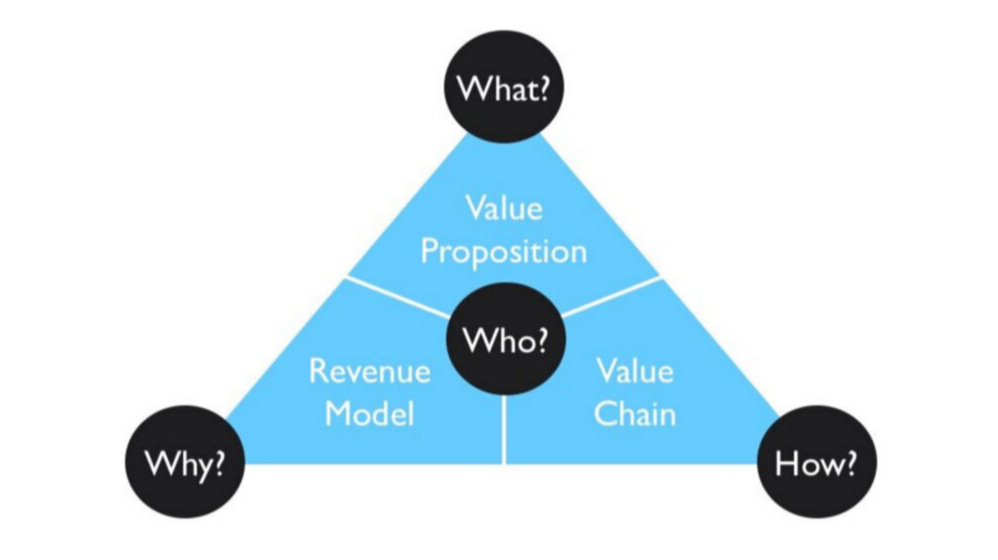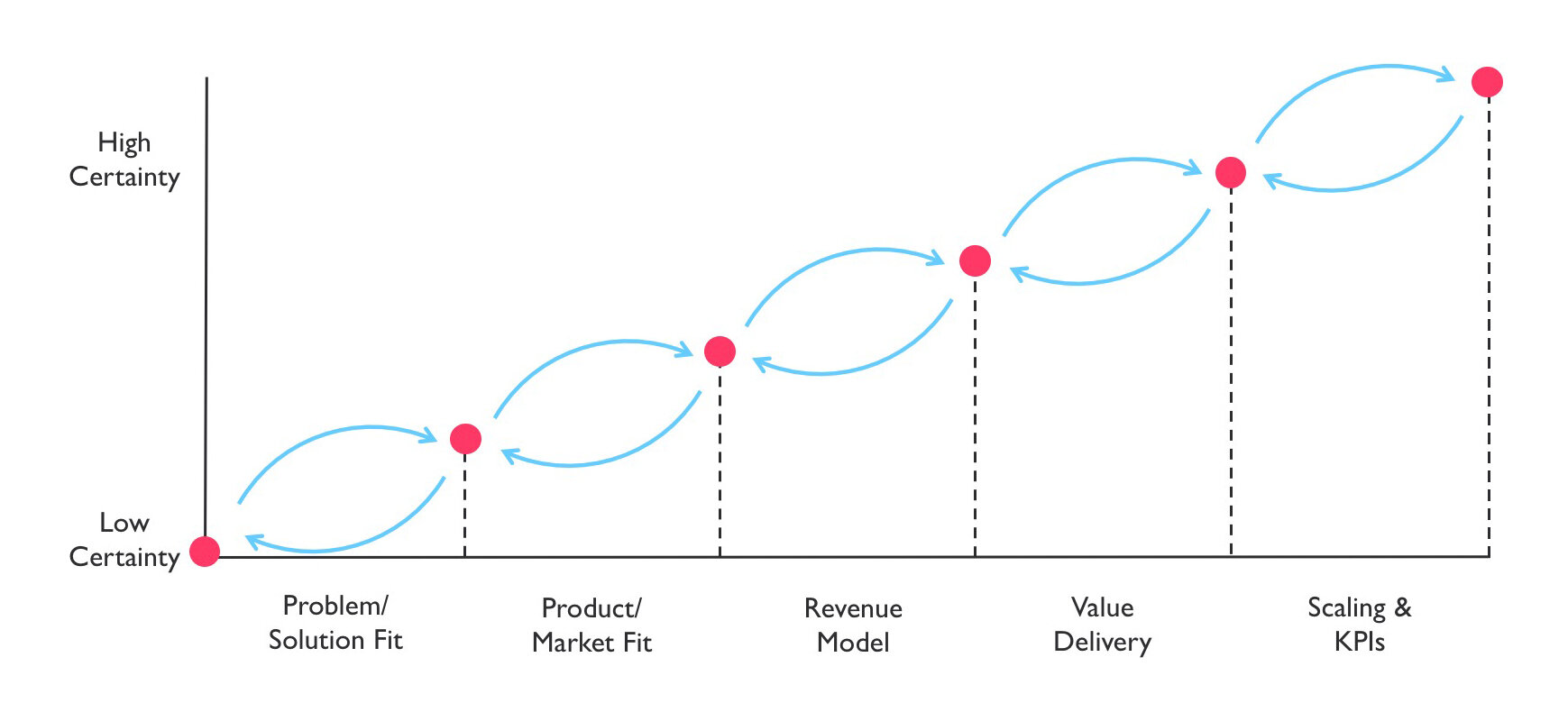Building on the reasons for using business models in our previous post, this time, we want to deep dive into the implementation of digital business models.
The increasing popularity of creativity methods such as Design Thinking and the St. Gallen Business Model Navigator have led to a state where companies are now well equipped to generate many innovative ideas. The better the first step of business model innovation is mastered, the clearer it becomes that the true challenges for companies lie in the following phases: translating ideas into validated business model concepts and turn them into profitable businesses.
Overall, formulating ideas is easier than validating and implementing them. This discrepancy has to do with the requirements of the company and its employees, as well as the frequent lack of a systematic validation approach. When innovation projects fall too early into the standard project management paths, false expectations and insufficient evaluation of the fundamentals may occur. Most companies are "implementation machines": they specialize in optimizing their current business model. The more successful they are, the more they create and adhere to strict processes and hierarchies. This is good for the company as it improves their performance within their current business. But new business models are inherently uncertain and as such should not be implemented in a linear fashion but tested and adapted iteratively. A further hurdle for many companies arises from the predominantly digital focus of new business models. Since IT plays a secondary, supporting role, digital business models bring about further changes and requirements. With digital business models, the core of service provision relies on the IT and is therefore automatically the focus of implementation efforts. Due to this, companies often miss the fact that this does not necessarily mean that IT is also at the core of the value proposition.
One example: Klickrent is a digital marketplace for construction technology rentals. As a subsidiary of the Zeppelin Group, this solution cannibalizes the business of its parent company, as the platform acts independently from the manufacturer. While the services are delivered via the platform and therefore largely handled digitally, the value proposition focuses on the ability to easily rent or lease the appropriate construction technology. For this reason, to validate this business model, the initial focus should not be around building the full digital platform, but rather around the need to rent or lease specialized construction technology. However, since most companies are more experienced in handling technical requirements, the first steps around the value proposition validation are often missed. In later stages, this usually leads to critical problems such as redevelopment cost, missing product/market fit and technological roadblocks - learnings for which companies pay a very high price.
The prerequisite: Choosing the right ideas
Evaluating and choosing among a large number of innovative ideas is a key step that supports the development of a portfolio of new business models which, in turn, needs to be aligned with the vision as well as the strategy of the company. The more diverse the pursued ideas, the more this helps to prevent downturns and crises by diversifying and developing new markets and sales channels. The flip side: the further away the idea is from the core business, the riskier it is because there is little or no experience available. The market cannot be assessed easily, and new sales channels must be built from scratch. However, to build a mixed business model portfolio, companies need to pursue this type of ideas. The same holds true for the time horizon: new business model ideas can be pursued along different time horizons to support sustainable and long-term growth goals while at the same time familiarizing the company and its employees with the process of assumptions-based business model innovation with short-term ideas to achieve quick wins.
As described in our previous post, a business model consists of four dimensions: (WHO) is the target customer and what his/her needs, (WHAT) is the value proposition and with the help of which products and services is it generated, (HOW) is the value proposition delivered and (WHY) is the business model profitable?
In addition to the aforementioned criteria regarding strategy and company fit, the business model dimensions also serve as a basis for evaluating ideas. Important criteria for the WHO dimension are, for example, market growth, the relevance of the customer problem or need, or the strategic importance of the targeted customer segment for the company. Evaluation Criteria for the WHAT dimension include, besides the added value per se, aspects such as the scaling or further development potential of the products/services offered. The maturity of the technology used, existing synergy effects, and the customer's own share in the value generation are criteria for the HOW-dimension. The customer's willingness to pay and the needed investment to introduce the idea to the market are criteria for the WHY dimension.
Digital business model ideas typically have higher scaling potential and a broader range of payment models that are accepted by customers. However, for companies that do not consider IT as their core competence, highly digitalized solutions are often associated with additional organizational challenges: different development processes and invoicing schemes as well as a change in service provision, since the focus is often on the delivery of digital services instead of product sales. This requires the acceptance of longer implementation periods, an increased willingness for change in top management and, in addition, often an adjustment of the corporate culture and employee capabilities.
The approach: Assumption-based business model development
The next step focuses on validating the selected business model ideas as effectively and quickly as possible. For many companies, the underlying uncertainty of new business model ideas is the main difference to their usual way of doing business. Since the ideas are often outside the company's core market, new customer segments or existing customers must be acquired in a different way in order to implement the ideas. As a result, companies are confronted with challenges for which they have little or no experience and for which reliable forecasts are difficult or impossible.
A proven way to systematically validate and implement business models in this type of environment is what we call assumption-based business model development. This approach reduces the inherent uncertainty of the business model by checking the most critical assumptions at each step. The iterative process is executed with the least possible investment of time and resources and allows the concept to be adapted to what has been learned or, in case of doubt, to be stopped early.
These assumptions concern, for example, internal aspects such as the technical feasibility of the solution, the required resources, the implementation times or available capabilities. However, the most important assumptions in the early development stages always concern the customer.
The approach can be divided into 5 phases according to the most important milestones for implementation. With each phase the uncertainty is reduced as the company learns, adapts the business model and ultimately decides at each step whether it is worth pursuing the idea or not.
Step 1: Problem/Solution-Fit
The first step after detailing a business model idea is the so-called Problem/Solution-Fit. This is where the assumed problems and needs of the customer are validated. In addition, the early customer interaction allows to evaluate whether the imagined solution can satisfy the needs or solve the problems and whether the customer in interested in learning more about it. In this phase the company must focus on qualitative aspects to learn as much as possible from the customer and develop a suitable solution. At the same time, it is important to narrow down the market and identify the customer group that has the biggest problem and is therefore most interested in the solution.
If the most important assumptions are not confirmed, the analysis of the learnings helps to understand why there is no fit and what previously unknown problems the customer is facing. It is important to note that the right approach is critical for the success of this phase. Companies must iterate and repeat the steps accordingly. This is valid for all steps of the approach. If the results indicate that the solution (or even any solution) is not needed, the concept should be killed as quickly as possible. This is one of the goals of the whole process: quickly find what doesn’t work and move on.
Step 2: Product/Market-Fit
Once the fit between customer problems and solution is validated, the Product/Market-Fit phase checks whether customers are interested in the business model as a whole, including the mix of services, products and its features. The main objective is to identify the "must-haves" and the overall desirability of the solution. This can only be achieved through visualizations, Minimal Viable Products (MVPs) and direct customer interaction. It is crucial to incorporate what has been learned directly into the solution and to verify the improved version again.
Step 3: Willingness to Pay
This third step is about deep diving into the revenue model. Many companies find it very difficult to not check the willingness of customers to pay until this step, as this is the crucial aspect from their point of view. Ultimately, however, the direct interest of the customer, which is checked in the previous phases, is the most concrete indication to this point that a profitable business model can be developed. A reliable assessment of the willingness to pay can only be achieved once the value proposition and its related product and service offerings have been defined so exactly that any customer can understand it. Otherwise, companies run the risk of overestimating unspecific approval from previous phases and risk too much too quickly.
Step 4: Value Delivery Phase
As soon as the willingness to pay has been validated and pilot customers have been identified, the Value Delivery Phase can be used to map and develop the production and logistics processes needed, which cooperation partners are necessary and how the exact cost structure will look like.
Usually, engineering companies have troubles to wait until this stage to start working on this dimension of a business model. Again, this comes down to the business-as-usual, where the optimization of the HOW dimension is the key to improve performance. What we often see is that teams try to assess how the concept they generated can be turned into reality, which typically either results in the abandonment of the idea as it is deemed as too difficult, or in a rush towards the technical realisation of the concept. In doing so, companies ignore the basic idea of the approach, which aims at quickly and cheaply testing business models, especially in the early stages, where there is no validated value proposition and clear solution designed: as long as uncertainty is high, the concepts often change tremendously – which in turn changes the technical requirements. The usual result is the development of a product or a solution that no one wants to buy.
Step 5: Scaling & KPIs
In the last step prior to the (pilot) market entry it is necessary to determine how the success of the business model actually looks like and how this can be measured. Here, typical growth and financial key figures may be enough, but due to the strategic character of new business models, aspects such as synergy effects and scaling potential are also important factors. In addition, after this step, the business model turns from a project into a product that needs to be managed accordingly. Thus, either the handover to the main organisation or the foundation of a separate entity needs to be planned.
The technology: Business model validation using digital frameworks / technical pitfalls for business model validation
Two of the characteristics of digital solutions are their potential for rapid adaptability and scalability. This means that such solutions often offer more freedom in development. At the same time, results can be visualized, tested and adapted more quickly. However, as already mentioned, it is not only the digital aspects that need to be validated, but the entire business model, especially the value proposition. The decisive factor here is that the chosen technological basis offers the flexibility and modularity required for the assumption-based approach.
This can best be illustrated with Industry 4.0. Hundreds of platforms already exist on the market, offering a wide range of ready-to-use functionalities. Due to the number of offerings, companies quickly start by evaluating the available platforms, as this is a well-known process.
With this approach, companies remain in familiar territory - but unfortunately on the wrong track. On the one hand, a technical evaluation that goes along with this procedure requires a significant amount of time. Even more problematic is the fact that this approach tricks the companies into believing that all that is needed is to find and implement the right platform in order to offer the best solution. The technical implementation is then mistaken for the overall goal - the introduction of a validated, profitable business model. Often it is only after the implementation of the platform that it becomes clear that the planned offers and products will not find a buyer as the generated value is too low or does not meet the customers’ needs. If meaningful services are created nonetheless, the company is often firmly tied to a platform, even if the needs and requirements change as the offerings evolve. Changing platforms is then only possible at high costs and with further delays.
In order to avoid this, it is crucial to develop the technical aspects as effectively and targeted as is possible to validate the most critical business model assumptions in each development phase. This is where modular frameworks come in handy. Whereas existing platforms are primarily about selling a modular, but above all standardized product, the development of a framework focuses on HOW and WHAT: what should be offered to the customer? Does this meet the need of the customer? What are the most important features? As a result, from a technical point of view, the thinking is already in line with the assumption-based approach. This ensures that only those services and functionalities are implemented that have been proven to be desired by the customer. At the same time, in contrast to the implementation of a full-fledged platform, there is the possibility of stopping the project prematurely if the customer provides appropriate feedback.
This comes with a lower price tag than implementing a full platform and allows switching to a suitable existing solution before scaling or – if that does not exist – to create your own scalable solution accordingly.
Thus, the 5 major takeaways are:
Understand and solve your customers problem and needs first, then think about technology.
A digital business model does not necessarily imply a purely digital value proposition.
Developing digital business models happens under great uncertainty, rely on data and facts instead of opinions to reduce it.
A lean approach makes it easier to abort the project if necessary, in order to pursue one of the many other ideas.
All parties involved need to understand the importance of developing and testing new business models and create enough organizational freedom to allow for it.
If you want to learn more, feel free to take a look into our testing methodology and testing cards here.



